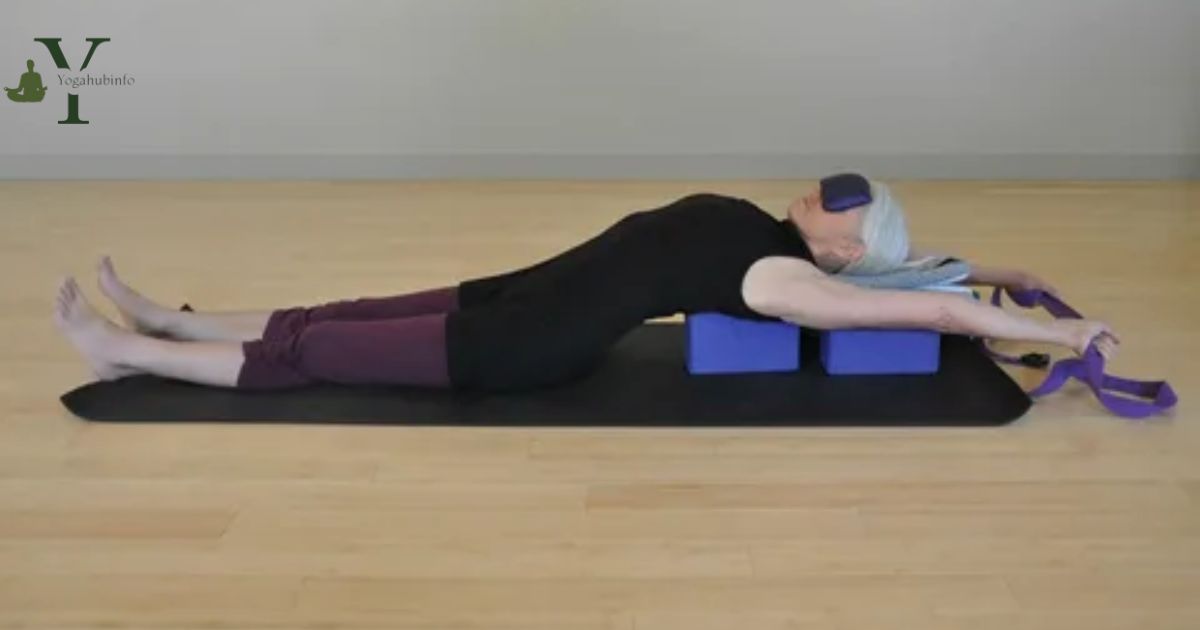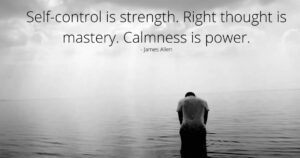Answer. Shoulder and chest opening yoga poses enhance flexibility, alleviate tension, and promote better posture for overall well-being and a more expansive range of motion.
Shoulder and Chest Opening Yoga Poses involve stretching and expanding the muscles in your shoulders and chest. These poses aim to improve flexibility, relieve tension, and enhance posture. By opening these areas, you may experience reduced stiffness and increased range of motion. Incorporating these poses into your routine can contribute to overall well-being and relaxation.
Discover a world of relaxation with Shoulder and Chest Opening Yoga Poses?. Release tension and enhance flexibility as you explore these rejuvenating poses. Embrace the soothing stretch of each movement, promoting both physical and mental well-being. Elevate your yoga practice and unlock a path to a more open and invigorated body.
Unlock tightness and enhance flexibility with Shoulder and Chest Opening Yoga Poses. These poses stretch and strengthen muscles in your upper body. Improve posture and relieve tension as you incorporate these poses into your yoga routine. Enjoy the benefits of increased mobility and a more open and relaxed chest and shoulders.
Yoga Poses to Open Your Chest in Your Workout Routine
| Pose Name | Description |
| Cobra Pose | Lie on your stomach, place your hands under your shoulders, and lift your chest while keeping your pelvis on the floor. |
| Upward-Facing Dog | Similar to Cobra Pose but with your thighs and the tops of your feet lifted off the mat, creating a deeper stretch in the chest. |
| Camel Pose | Kneel on the mat, lean back, and reach for your heels with your hands. Arch your back, opening up your chest and stretching the front of your body. |
| Bridge Pose | Lie on your back, bend your knees, and lift your hips towards the ceiling. Clasp your hands under your back to open up your chest and shoulders. |
| Fish Pose | Lie on your back, lift your chest, and place your forearms and elbows on the mat. Arch your back, opening up the chest and throat. |
| Wheel Pose | Lie on your back, bend your knees, place your hands by your shoulders, and push your chest up, straightening your arms. A more advanced pose for chest opening. |
Incorporating yoga poses that focus on opening the chest can be a valuable addition to your workout routine. These poses not only enhance flexibility and strength but also promote better posture and respiratory function. By targeting the chest region, these yoga poses help counteract the effects of prolonged sitting and slouching, which are common in our modern lifestyles. Here are some effective yoga poses to open your chest and bring balance to your workout routine:
- Cobra Pose (Bhujangasana)
- Start by lying on your stomach with your hands placed under your shoulders.
- Inhale and lift your chest off the ground, keeping your elbows slightly bent.
- Arch your back and engage your glutes, looking upward.
- Hold the pose for a few breaths, feeling the stretch in your chest and front body.
- Upward-Facing Dog Pose (Urdhva Mukha Svanasana)
- Begin in a plank position with your wrists directly under your shoulders.
- As you inhale, straighten your arms and lift your chest while keeping your legs extended and toes pointing.
- Ensure your shoulders are away from your ears, and your chest is open and expanded.
- Hold the pose, feeling the stretch in your abdominal and chest muscles.
- Camel Pose (Ustrasana)
- Kneel on the mat with your knees hip-width apart.
- Tilt your pelvis forward and arch your back, reaching your hands back to grasp your heels.
- Open your chest towards the ceiling, lifting your heart and lengthening your spine.
- Hold the pose while breathing deeply, feeling the stretch across your chest.
- Bridge Pose (Setu Bandhasana)
- Lie on your back with your knees bent and feet hip-width apart.
- Press through your feet to lift your hips towards the ceiling.
- Clasp your hands under your back and roll your shoulders beneath you.
- Lift your chest towards your chin, creating a gentle backbend and opening the front of your body.
- Fish Pose (Matsyasana)
- Begin by lying on your back with your legs extended and arms by your sides.
- Place your hands underneath your hips, palms facing down.
- Press through your forearms and lift your chest, arching your back and tilting your head back.
- Feel the stretch across your chest and throat, opening up the front of your body.
- Thread the Needle Pose (Parsva Balasana)
- Start in a tabletop position with your wrists under your shoulders and knees under your hips.
- Slide your right arm under your left arm, lowering your right shoulder and temple to the mat.
- Gently twist your upper body, feeling a stretch along the outer edge of your right shoulder and chest.
- Repeat on the other side.
Incorporating these yoga poses into your workout routine can help improve your chest flexibility, enhance your posture, and provide a counterbalance to activities that may contribute to a rounded shoulder posture. Remember to focus on your breath and listen to your body, gradually deepening the stretches as you become more comfortable with each pose.
Crafting a Tranquil Haven: 10 Suggestions for Establishing a Relaxing, Stress-Free Home Environment
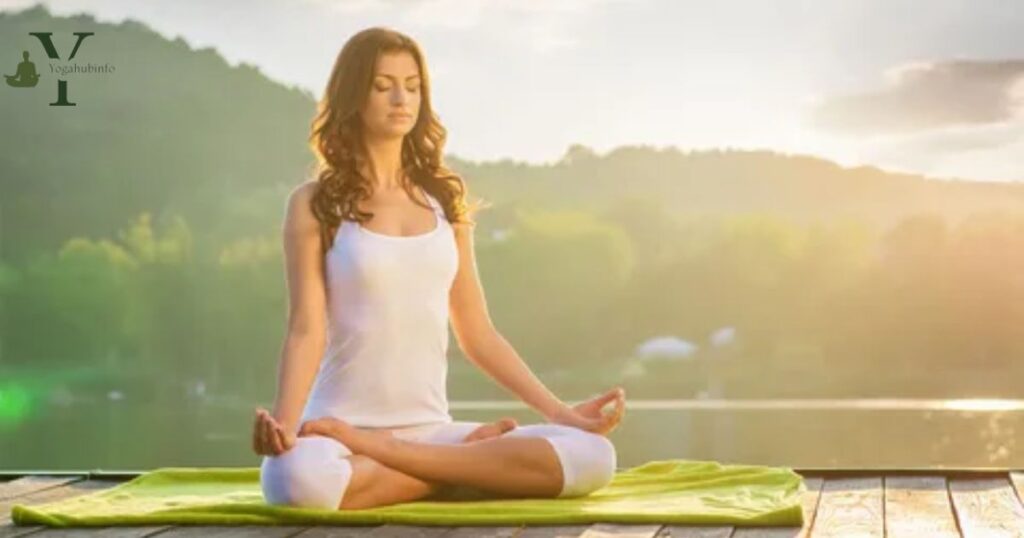
Declutter and Simplify
- Begin by decluttering your living space. Remove unnecessary items and embrace a minimalist approach. A clutter-free environment promotes a sense of calm and order, allowing your mind to relax and recharge.
Natural Elements
- Incorporate natural elements into your home decor. Use houseplants to bring a touch of nature indoors. The presence of greenery not only improves air quality but also creates a refreshing and calming atmosphere.
Soft Lighting
- Opt for soft, warm lighting instead of harsh, bright lights. Use lamps, candles, or string lights to create a cozy ambiance. Soft lighting can have a profound impact on your mood, fostering a sense of tranquility.
Comfortable Seating and Bedding
- Invest in comfortable and inviting seating arrangements. Your furniture should be a haven for relaxation. Likewise, ensure your bedding is comfortable and conducive to a good night’s sleep. Quality sleep is crucial for reducing stress.
Mindful Colors
- Choose calming and soothing colors for your home. Soft blues, greens, and neutral tones can have a serene effect on the mind. Avoid overly vibrant or jarring colors in spaces where you want to relax.
Personal Retreat Spaces
- Create small retreat spaces within your home dedicated to personal relaxation. This could be a reading nook, a meditation corner, or a cozy window seat. Having designated spaces for unwinding adds depth to your tranquil haven.
Aromatherapy
- Engage your senses with aromatherapy. Use essential oils, scented candles, or incense to fill your home with calming fragrances. Scents like lavender, chamomile, and eucalyptus are known for their stress-relieving properties.
Technology Detox Zone
- Designate certain areas as technology-free zones. Create spaces where you can disconnect from screens, allowing your mind to unwind without the constant stimulation of electronic devices.
Organized Spaces
- Maintain an organized home to reduce daily stress. Establish routines for tidying up, and ensure that everything has its designated place. An organized environment contributes to a sense of order and peace.
Soft Sounds and Music
- Integrate soft sounds or soothing music into your daily life. Whether it’s the gentle rustling of leaves, the sound of ocean waves, or calming instrumental music, audio elements can greatly enhance the tranquility of your home.
Enhance Your Upper Body Strength with These Four Yoga Poses for Opening the Shoulders and Chest
Downward-Facing Dog (Adho Mukha Svanasana)
Downward-Facing Dog is a foundational yoga pose that engages the entire upper body, including the shoulders and chest. This pose helps stretch and strengthen the shoulders, arms, and upper back while also promoting spinal alignment.
- Beggin on your hands and knees, with your wrists aligned under your shoulders and knees under your hips.
- Lift your hips toward the ceiling, straightening your legs, and bring your heels toward the floor.
- Press your palms into the mat, actively engaging your shoulders while lengthening your spine.
- Hold this pose for 30 seconds to a minute, breathing deeply and focusing on the stretch in your shoulders and chest.
- Cobra Pose (Bhujangasana)
Cobra Pose is an excellent yoga posture for opening the chest and strengthening the muscles along the spine. This pose targets the shoulders, chest, and the muscles of the upper back, improving posture and flexibility.- Lie on your stomach with your legs extended and the tops of your feet on the mat.
- Place your hands under your shoulders, fingers pointing forward.
- Inhale and lift your chest off the mat, keeping your elbows slightly bent and shoulders relaxed.
- Hold Cobra Pose for 15-30 seconds, gradually increasing the duration as your strength improves.
- Camel Pose (Ustrasana)
Camel Pose is an advanced yoga pose that deeply stretches the chest, shoulders, and abdomen while strengthening the upper back. This backbend requires flexibility and balance, promoting an open and expansive feeling in the chest.- Kneel on the mat with your knees hip-width apart.
- Tuck your toes under, lift your hips, and place your hands on your lower back.
- Arch your back, reaching your hands toward your heels while keeping your chest lifted.
- Hold Camel Pose for 20-30 seconds, focusing on the expansion of the chest and the engagement of the upper back.
- Bridge Pose (Setu Bandhasana)
Bridge Pose is an effective yoga pose for not only strengthening the upper body but also opening the shoulders and chest. This pose engages the muscles in the back, shoulders, and chest while also providing a gentle stretch to the neck and spine.- Lie on your back with your knees bent and feet hip-width apart.
- Press your feet into the mat as you lift your hips toward the ceiling.
- Clasp your hands under your back, rolling your shoulders under and opening your chest.
- Hold Bridge Pose for 30 seconds to a minute, focusing on the lift of the chest and the strength in your shoulders.
Transform your core workout routine into an enjoyable and engaging experience with these 8 dynamic yoga ball exercises.
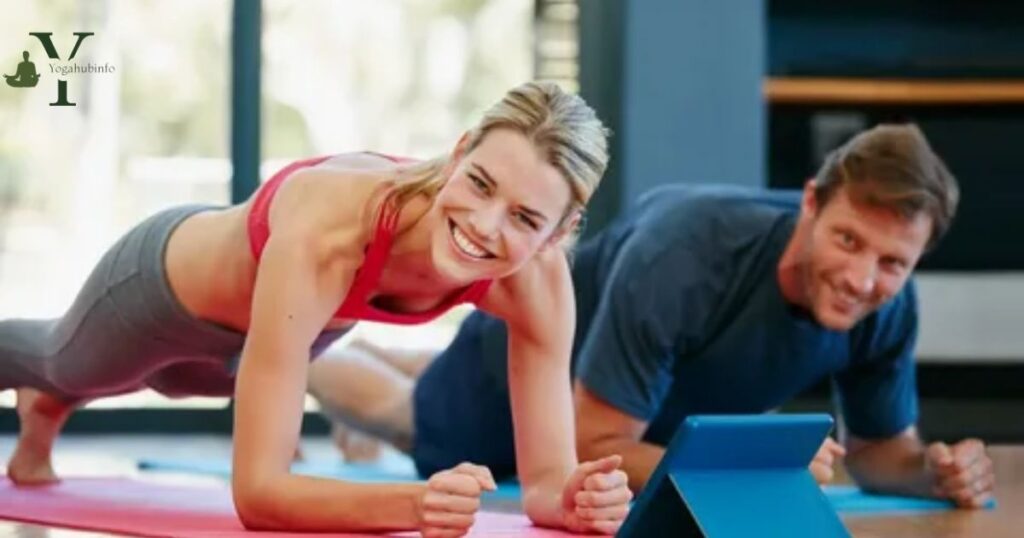
Unleash the power of a dynamic core workout that transcends the mundane and transforms into an enjoyable and engaging experience. Incorporating a yoga ball into your routine adds an element of fun and challenge, elevating your fitness journey to new heights. Embrace the fusion of traditional yoga poses with the instability of the yoga ball for a comprehensive and invigorating core workout.
Balancing Boat Pose with Stability Ball
- Begin your journey to a stronger core by incorporating the balancing boat pose with a stability ball. Engage your abdominal muscles to maintain balance on the ball, intensifying the benefits of this classic yoga pose. Feel the burn as you work on your core stability and overall strength.
Plank Rollouts
- Take the traditional plank to the next level by incorporating a yoga ball. Start in a plank position with your hands on the ball and roll it forward and backward. This dynamic movement engages your core, shoulders, and arms, providing a full-body workout that challenges your stability and strength.
Yoga Ball Pass
- Partner up for an interactive core exercise. Sit facing each other, both holding a yoga ball. Lean back simultaneously, passing the ball to your partner. The constant movement engages your core muscles and enhances coordination, turning a simple pass into a dynamic core workout.
Yoga Ball Mountain Climbers
- Elevate the intensity of mountain climbers by placing your hands on a yoga ball. Bring your knees towards your chest in a controlled and deliberate manner, engaging your core muscles. This exercise not only targets your abs but also improves cardiovascular fitness.
Yoga Ball Russian Twists
- Sit on the yoga ball with your feet flat on the floor. Lean back at a 45-degree angle, engaging your core. Hold the ball with both hands and rotate your torso from side to side. This twisting motion targets your obliques, enhancing your core strength and flexibility.
Bridge Pose with Leg Lifts
- Lie on your back with your feet on the yoga ball, lifting your hips into a bridge pose. Add an extra challenge by lifting one leg at a time while maintaining stability on the ball. This exercise not only targets your core but also engages your glutes and hamstrings.
Yoga Ball Wall Squats
- Incorporate the stability ball into your wall squats for an enhanced lower body and core workout. Place the ball between your lower back and the wall, then lower into a squat position. The instability of the ball engages your core muscles as you work on strengthening your legs.
Yoga Ball Pike
- Assume a plank position with your hands on the floor and your feet on the yoga ball. Use your core muscles to lift your hips towards the ceiling, creating an inverted V shape. This challenging exercise targets your entire core, shoulders, and upper back.
Want to save this workout or page?
Saving a workout or page is a valuable functionality that serves various purposes. Here’s a brief exploration of the reasons behind saving a workout or page:
- Progress Tracking: Saving a workout enables users to track their fitness journey over time. By storing each session, users can review their achievements, identify trends, and assess their overall progress.
- Consistency and Routine: For individuals following a specific workout routine, saving each session helps in maintaining consistency. It serves as a digital logbook, ensuring that users can easily refer back to their planned exercises, sets, and reps.
- Customization and Planning: Users often customize their workouts based on personal preferences, fitness goals, and physical abilities. Saving a workout allows individuals to plan and organize their exercises in advance, streamlining the preparation process for future sessions.
- Sharing and Community Engagement: Some platforms encourage users to share their workouts with friends or the broader fitness community. Saving a workout facilitates easy sharing, fostering a sense of community and enabling users to motivate and inspire each other.
- Analysis and Optimization: By saving workouts, users can analyze their training patterns and optimize their routines. This data-driven approach can help individuals make informed decisions about adjusting their exercises, increasing intensity, or targeting specific muscle groups.
- Backup and Security: Saving workouts provides a form of backup, ensuring that users don’t lose their hard work in case of device issues, app updates, or other unforeseen circumstances. It adds a layer of security to the time and effort invested in building a fitness routine.
- Cross-Platform Accessibility: Saving workouts often allows users to access their routines across multiple devices. This flexibility is beneficial for those who switch between smartphones, tablets, and computers, ensuring a seamless experience regardless of the device used.
FAQs about Power Yoga
1. What is Power Yoga?
Power Yoga is a dynamic and vigorous form of yoga that combines traditional yoga poses with a more intense, fitness-focused approach, emphasizing strength, flexibility, and breath control.
2. How does Power Yoga differ from traditional yoga?
Unlike traditional yoga, Power Yoga involves a faster pace and continuous movement, challenging practitioners to build endurance, enhance muscle tone, and experience a more cardio-intensive workout.
3. Is Power Yoga suitable for beginners?
Yes, Power Yoga can be adapted for beginners, but it’s essential to start with basic poses and gradually progress to more advanced sequences, ensuring a safe and gradual development of strength and flexibility.
4. What are the benefits of Power Yoga?
Power Yoga offers a holistic approach, providing benefits such as improved strength, flexibility, balance, and mental focus, making it an effective practice for both physical fitness and stress relief.
5. Can Power Yoga help with weight loss?
Yes, Power Yoga can contribute to weight loss by burning calories, increasing metabolism, and promoting overall body awareness. However, consistent practice and a balanced diet are key components for effective weight management.
6. How often should one practice Power Yoga?
For optimal results, practicing Power Yoga two to three times a week is recommended. Consistency is crucial, allowing the body to adapt and experience the full range of physical and mental benefits.
7. Are there any age limitations for practicing Power Yoga?
Power Yoga is generally suitable for individuals of various age groups, but it’s advisable to consult with a healthcare professional, especially for older adults or those with existing health concerns, to ensure it aligns with their fitness goals and capabilities.
15 minutes of yoga
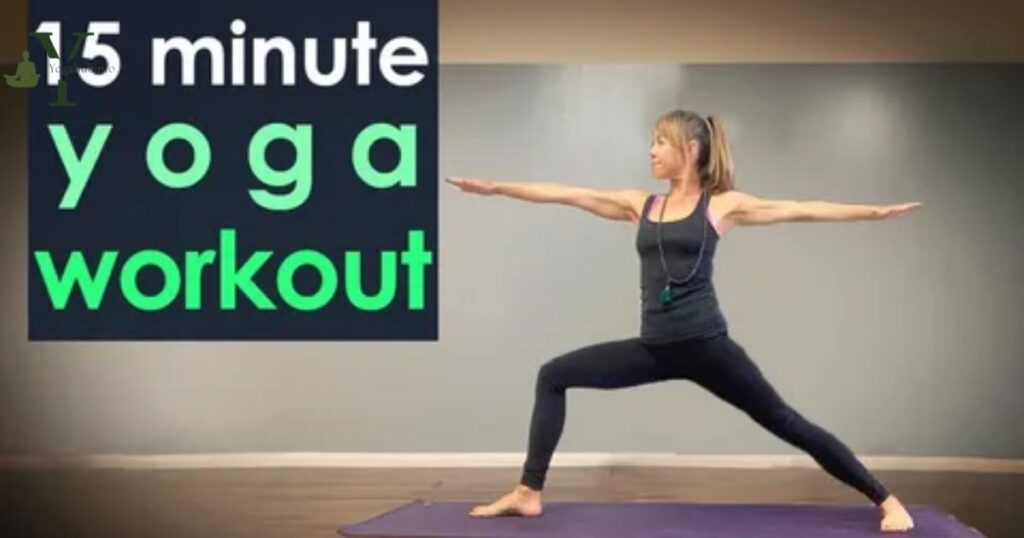
1. What is the significance of 15 minutes of yoga?
A brief but regular 15-minute yoga session can offer numerous physical and mental health benefits, making it an accessible and time-efficient option for individuals with busy schedules.
2. Quick Stress Relief
A short yoga practice helps reduce stress by incorporating breathing exercises and gentle stretches, promoting relaxation and calmness in a short time frame.
3. Improved Flexibility
Even a brief daily yoga routine can contribute to increased flexibility, targeting key muscle groups and enhancing joint mobility.
4. Enhanced Focus and Mental Clarity
The combination of movement and mindfulness in a 15-minute yoga session can sharpen mental focus and provide a mental reset, improving overall cognitive function.
5. Energizing Start to the Day
A morning 15-minute yoga routine can serve as a refreshing and energizing start, helping to awaken the body, boost circulation, and set a positive tone for the day ahead.
6. Better Posture
Regular short yoga sessions can aid in cultivating good posture habits, strengthening core muscles, and reducing the risk of musculoskeletal issues.
My Extra-Large Yoga Mat can be found here
If you’re searching for an expansive and accommodating yoga mat, look no further than the My Extra-Large Yoga Mat. This oversized mat is designed to provide ample space, ensuring comfort and freedom of movement during your yoga practice.
Generous Dimensions
The My Extra-Large Yoga Mat boasts generous dimensions, offering a wide and long surface that accommodates practitioners of all sizes. With extra space to stretch and move, it enhances the overall yoga experience.
Comfortable Thickness
Crafted with a comfortable thickness, this mat provides adequate cushioning to support your joints and spine. Whether you’re engaging in gentle stretches or more challenging poses, the mat’s padding offers a supportive foundation.
Non-Slip Surface
Featuring a non-slip surface, the mat ensures stability and prevents slippage, even during the most dynamic yoga sessions. This attribute is particularly valuable for maintaining proper alignment and focus throughout your practice.
Durable and Long-Lasting
Constructed from high-quality materials, the My Extra-Large Yoga Mat is built to withstand regular use. Its durability ensures a long lifespan, making it a reliable companion for your yoga journey.
Versatile for Various Workouts
Beyond yoga, this extra-large mat is versatile enough for other fitness activities, such as Pilates, stretching exercises, or home workouts. Its expansive surface accommodates diverse fitness routines.
Easy to Clean
Maintaining hygiene is made easy with the mat’s user-friendly design. Simply wipe it down with a damp cloth or use a mild yoga mat cleaner to keep it fresh and ready for your next practice.
Portable and Lightweight
Despite its size, the mat remains portable and lightweight, making it convenient to roll up and transport to your yoga studio, gym, or outdoor practice area.
Stylish Design Options
The My Extra-Large Yoga Mat is available in a variety of stylish designs, allowing you to choose a mat that reflects your personal style and enhances the visual appeal of your workout space.
Ideal for Home Workouts
With the rise of home workouts, having a spacious mat is essential. The My Extra-Large Yoga Mat is well-suited for creating a dedicated and comfortable space for your daily yoga practice within the comfort of your home.
Customer Reviews
Check out the positive feedback from satisfied customers who have experienced the benefits of the My Extra-Large Yoga Mat. Real testimonials can provide insights into how this mat has enhanced the yoga practice of others.
Invest in your well-being and elevate your yoga practice with the My Extra-Large Yoga Mat.
Instructions for the workout
Whether you’re a seasoned fitness enthusiast or just beginning your journey to a healthier lifestyle, following clear instructions for your workout is essential. Here’s a guide to ensure a safe and effective exercise session:
1. Warm-Up
Start with a dynamic warm-up to increase blood flow to your muscles and prepare your body for the upcoming workout. Include light cardio, dynamic stretches, and joint mobilization exercises.
2. Set Clear Goals
Define your workout goals to tailor the routine to your specific needs. Whether it’s building strength, improving flexibility, or increasing endurance, having clear objectives enhances the effectiveness of your workout.
3. Choose Appropriate Exercises
Select exercises that align with your fitness goals. Include a mix of cardio, strength training, and flexibility exercises to create a well-rounded routine. Ensure the exercises are suitable for your fitness level.
4. Pay Attention to Form
Maintain proper form throughout each exercise to prevent injuries and maximize results. Focus on controlled movements, engage the correct muscles, and avoid overexertion.
5. Include Progressions
For those seeking continuous improvement, incorporate progressive elements into your workout. Gradually increase intensity, resistance, or duration to challenge your body and stimulate positive adaptations.
6. Rest Intervals
Allow adequate rest intervals between sets to promote recovery. The duration of rest depends on the intensity of the workout and your fitness goals. Shorter rest for cardiovascular benefits, longer rest for strength-building.
7. Hydration
Stay hydrated throughout your workout. Have a water bottle accessible and take sips between exercises. Proper hydration is crucial for optimal performance and overall well-being.
8. Listen to Your Body
Pay attention to how your body responds during the workout. If you experience pain (not to be confused with muscle fatigue), consider modifying the exercise or consulting with a fitness professional.
9. Cool Down
End your workout with a proper cool-down. Incorporate static stretches to help reduce muscle soreness, improve flexibility, and promote a gradual return to a resting state.
10. Post-Workout Nutrition
Refuel your body with a balanced post-workout snack or meal. Include a combination of protein and carbohydrates to support muscle recovery and replenish energy stores.
11. Track Your Progress
Keep a workout journal or use a fitness app to track your progress. Documenting your exercises, sets, and repetitions can help you monitor improvements, stay motivated, and adjust your routine accordingly.
12. Consistency is Key
Achieving fitness goals requires consistency. Stick to your workout routine, but also allow for rest days to prevent burnout and support overall recovery.
13. Consult a Professional
If you’re new to exercise or have specific health concerns, consider consulting with a fitness professional or healthcare provider. They can provide personalized guidance and ensure your workout aligns with your individual needs and limitations.
Workout equipment
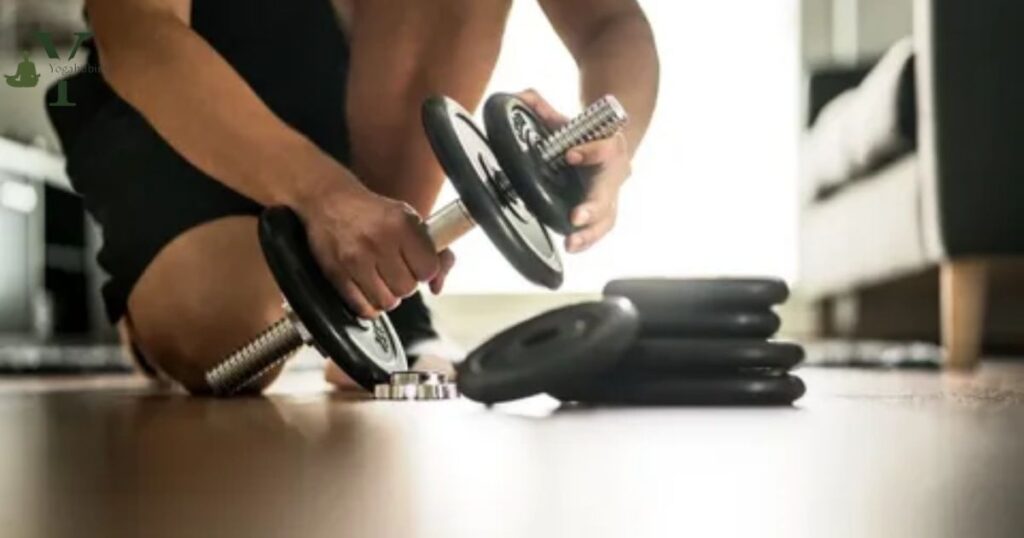
Achieving your fitness goals often involves incorporating various workout equipment to add diversity, intensity, and challenge to your exercise routines. Whether you’re working out at home, in a gym, or outdoors, choosing the right equipment can enhance your workouts. Here’s a guide to some common workout equipment:
1. Dumbbells
Versatile and effective, dumbbells are fundamental for strength training. They allow for targeted muscle isolation and can be used for a wide range of exercises, from bicep curls to lunges.
2. Resistance Bands
Compact and portable, resistance bands offer a full-body workout by adding resistance to various exercises. They are excellent for toning muscles, improving flexibility, and providing a low-impact alternative to traditional weights.
3. Kettlebells
Kettlebells combine cardiovascular and strength training. They are versatile for swings, squats, and other dynamic movements, engaging multiple muscle groups simultaneously.
4. Stability Ball
Ideal for core strengthening, stability balls add an element of instability to exercises, requiring the engagement of stabilizing muscles. They are commonly used for exercises like planks, ball squats, and core workouts.
5. Jump Rope
A simple yet effective cardio tool, a jump rope is perfect for enhancing cardiovascular fitness, improving coordination, and burning calories. It’s a convenient and affordable option for at-home or on-the-go workouts.
6. Yoga Mat
Essential for yoga, Pilates, or any floor-based exercises, a yoga mat provides comfort and stability. It also serves as a hygienic barrier between your body and the floor during workouts.
7. Medicine Ball
Ideal for dynamic strength training, medicine balls come in various weights. They are great for exercises like wall balls, slams, and twists, adding a dynamic element to your workout routine.
8. Foam Roller
Often used in post-workout recovery, a foam roller aids in self-myofascial release, helping to alleviate muscle tightness and improve flexibility. It’s a valuable tool for promoting muscle recovery and preventing injuries.
9. TRX Suspension Trainer
Offering a full-body workout using your body weight, a TRX suspension trainer is versatile for both strength and flexibility training. It can be anchored to a door, tree, or any sturdy structure.
10. Treadmill or Elliptical Machine
For cardiovascular fitness, treadmills and elliptical machines provide indoor options. They offer adjustable intensity levels, making them suitable for users of different fitness levels.
11. Pull-Up Bar
Perfect for upper body strength, a pull-up bar can be mounted in a doorway or attached to a sturdy structure. It’s excellent for pull-ups, chin-ups, and hanging leg raises.
12. Rowing Machine
An effective full-body workout machine, a rowing machine simulates the motion of rowing a boat. It engages multiple muscle groups and provides a low-impact cardiovascular exercise.
13. Bench
A sturdy workout bench is essential for various strength training exercises, including bench presses, step-ups, and tricep dips. It adds versatility to your home gym setup.
14. Elliptical Trainer
Combining the benefits of running and cycling, an elliptical trainer provides a low-impact cardiovascular workout. It’s gentle on the joints while offering an effective calorie burn.
15. Fitness Tracker
While not a traditional piece of equipment, a fitness tracker is a valuable tool for monitoring your progress, tracking steps, calories burned, and ensuring you meet your daily activity goals.
Warrior 2 Pose With Shoulders And Arms
The Warrior 2 Pose, or Virabhadrasana II, is a powerful standing yoga pose that emphasizes strength, stability, and focus. When combined with specific attention to shoulders and arms, this variation enhances the overall benefits, promoting both physical and mental well-being.
Instructions:
- Starting Position
- Begin in a standing position at the top of your yoga mat.
- Step one foot back, keeping it parallel to the back edge of the mat. The front foot points forward.
- Align Your Feet
- Align the heel of your front foot with the arch of your back foot, creating a comfortable distance between your feet.
- Ground both feet firmly into the mat.
- Open Your Hips and Shoulders
- Extend your arms parallel to the floor, palms facing down.
- Simultaneously, open your hips towards the side of the mat, ensuring they are in line with the shoulders.
- Bend Your Front Knee
- Bend the front knee, aiming for a 90-degree angle, ensuring the knee is directly above the ankle.
- Keep the back leg straight and engaged.
- Engage Your Core
- Draw your navel in towards the spine to engage your core muscles.
- Maintain a neutral spine, keeping your torso upright.
- Shoulder Awareness
- Lift your arms to shoulder height, ensuring they are parallel to the ground.
- Relax your shoulders away from your ears, creating space and releasing tension.
- Gaze Over the Front Fingertips
- Turn your head to gaze over the fingertips of your front hand, cultivating focus and concentration.
- Keep the neck in line with the spine.
- Hold the Pose
- Hold the Warrior 2 Pose for several breaths, feeling the strength and stability in your lower body and the openness in your shoulders.
- Focus on the sensation of grounding through your feet while simultaneously reaching out through your fingertips.
- Reverse Warrior Variation (Optional)
- To deepen the stretch, you can add a reverse warrior variation by gently reaching the back arm down the back leg and extending the front arm overhead.
Benefits
- Strengthens Legs: Warrior 2 builds strength in the quadriceps, hamstrings, and calves.
- Opens Hips and Shoulders: The pose enhances flexibility in the hips and shoulders, promoting a broader range of motion.
- Improves Focus: Gazing over the front fingertips cultivates concentration and mental focus.
- Stimulates Core Engagement: Engaging the core muscles adds a stabilizing element to the pose.
How To Do Warrior 2 Pose With Shoulders And Arms?
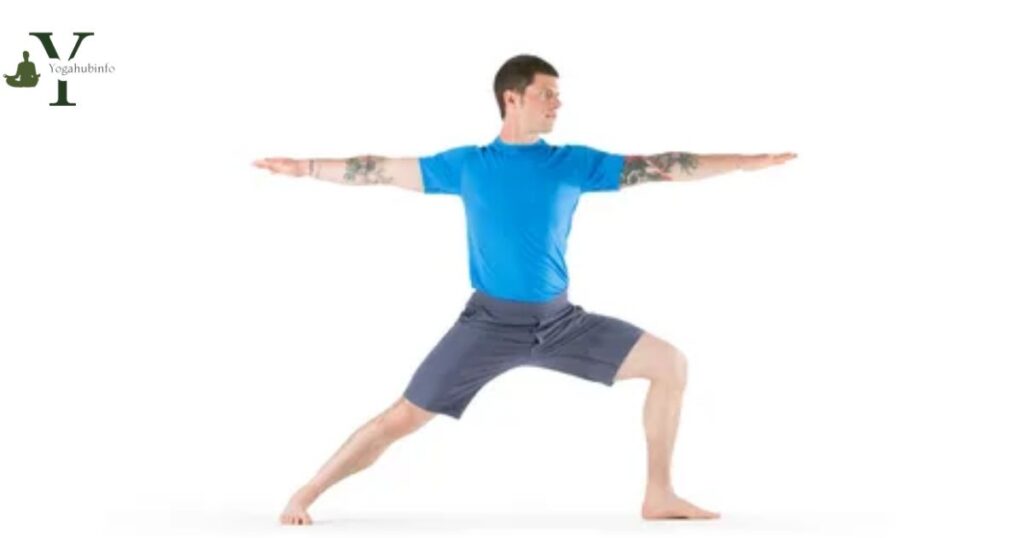
To begin the Warrior 2 pose, stand tall with your feet wide apart. Turn your right foot outward and bend your right knee, aligning it with the ankle. Extend your arms parallel to the floor, with palms facing down. Keep your shoulders relaxed and gaze over your right fingertips.
Ensure your left leg is straight and strong. Ground your back foot firmly on the mat. Engage your core for stability and maintain a steady breath. Feel the stretch in your inner thighs and the strength building in your arms and shoulders. Hold the pose for about 30 seconds to a minute, then switch sides.
For the left side, turn your left foot outward, bend your left knee, and extend your arms again. Keep your torso centered over your pelvis. Remember to breathe deeply, and if you find it challenging, you can modify the pose by adjusting the width of your stance. Warrior 2 is excellent for building strength, improving focus, and opening up your hips and chest.
Frequently Asked Questions
- What are the benefits of Shoulder and Chest Opening Yoga Poses?
- These poses help improve posture, increase flexibility, and relieve tension in the shoulders and chest.
- Can beginners practice Shoulder and Chest Opening Yoga Poses?
- Yes, many of these poses have modifications, making them accessible for practitioners at various levels.
- How often should one incorporate these poses into their yoga routine?
- It is recommended to practice these poses regularly, at least 2-3 times a week, to experience long-term benefits.
- Do Shoulder and Chest Opening Poses help with stress and anxiety?
- Yes, these poses can release built-up tension, promoting relaxation and reducing feelings of stress and anxiety.
- Are there any precautions to consider while practicing these poses?
- Individuals with shoulder or chest injuries should consult a yoga instructor or healthcare professional to ensure proper alignment and avoid potential strain.
Final thoughts
Engaging in shoulder and chest opening yoga poses can significantly enhance both physical and mental well-being. Firstly, these poses foster improved posture by releasing tension in the chest and shoulders, counteracting the negative effects of prolonged sitting and computer use. The opening of these areas also promotes better breathing patterns, enhancing lung capacity and overall respiratory function.
The practice of such yoga poses contributes to increased flexibility and range of motion in the upper body. This not only aids in preventing injuries but also supports better athletic performance in various activities. Additionally, the release of stored tension in the shoulders and chest has a calming effect on the mind, alleviating stress and promoting mental clarity.
Incorporating shoulder and chest opening yoga poses into one’s routine offers a holistic approach to physical and mental health. The benefits extend beyond mere flexibility, encompassing improved posture, enhanced respiratory function, injury prevention, and a heightened sense of calmness in the mind.
Unlock flexibility and release tension with invigorating shoulder and chest-opening yoga poses. Elevate your practice for a revitalized mind-body connection.

Marcus Evergreen, with 8 years of yoga expertise, is the author behind yogahubinfo.com, sharing insights and wisdom in holistic well-being.
